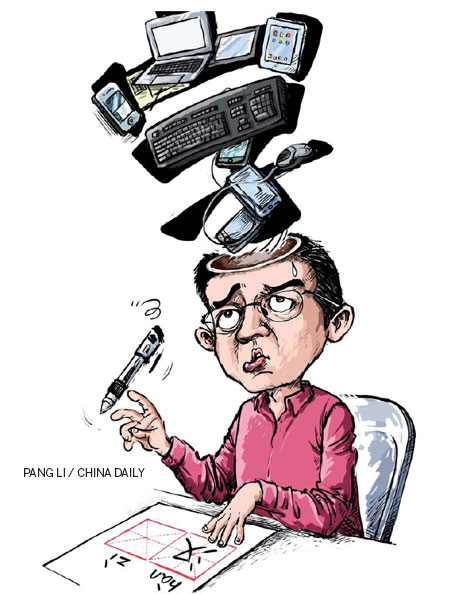Lost for words
Updated: 2013-08-30 10:03
By Raymond Zhou (China Daily)
|
|||||||||||


Computerization is debilitating our ability to hand-write Chinese characters. It is a sad trend that cannot be reversed. But the upside is higher efficiency in the use of the language as the bar for literacy keeps getting lowered
Amidst the numerous incarnations of singing contests that hog China's television screens, one show stands out for its originality (it's not based on an imported program format) and also for its educational value. It is a show about the dictation of Chinese characters. Surprisingly, it is fun and full of suspense as well.
The concept is simple: Groups of students from various provinces compete with each other by hand-writing Chinese words, or characters, that the host reads out to them. They can erase what they have written down until they submit it or time is up. The writing process is projected so both the live audience and the TV audience are witness to it. What's more, members of the live audience can participate by writing on their own pads.
The result is shocking: Many words that are hardly difficult become stumbling blocks for the youngsters, whose failure to write correctly sees them ejected from the competition.
The adults in the audience do even worse, with much lower scores, on average, than the formal contestants on the stage.
If this is an accurate gauge of Chinese people's ability to write Chinese words, it is clear we are losing the skill fast. By "writing" I refer to hand-writing only. The culprit, as everyone knows, is keyboard input, which has taken away the necessity to memorize all the strokes of Chinese characters. What has made writing so much easier is also chipping away at a foundation that many believe essential to be an educated person in China.
Now I have to provide a little background information for those not familiar with the Chinese language, the written one in this case. Unlike Western languages, the Chinese character is a pictograph, not pronounceable by the way it is written - even though it may contain an element for the sound. Each character is a picture for which you need to remember a series of strokes in order to write it.
Conventional wisdom suggests some 3,000 characters must be mastered in order to be able to write Chinese and a typical student spends much of his or her elementary school years training in this.
The desire to simplify this writing system is almost intuitive. Chinese teachers often dole out penalties to poorly performing students such as ordering them to write their name in characters 100 times. For this punishment, anyone called Ding Yi is the luckiest because this name requires just three strokes for both the given and family names. At the other extreme there can be 30 strokes in a name.
Nowadays, it is common for authors, when signing hundreds of autographs at one sitting, to adopt a cursive style of calligraphy that allows you to skip and combine strokes.
But for students, this simplified writing style isn't allowed and in fact would be regarded as something akin to a spelling mistake.
Now there are generally two ways to input Chinese characters on a standard keyboard: one is a system that turns each character into a sequence of usually four numerals, a system for which one has to memorize a set of rules and use regularly to be fast; and the other is pinyin, a form of Romanization that enables you to read out each character. If you know how a character is pronounced in Putonghua, the pinyin input is intuitive even though it requires another step of selecting the right character from a lineup of homonyms. According to one survey, 90 percent of all users depend on this method.
An emerging exception is the use of touch screen for hand-writing each character, prompting several look-alike characters to appear from which you can then select the right one. People who don't speak correct putonghua or have never learned pinyin, mostly those of an older generation, have found this useful.
Three decades of widespread use of personal computers and gadgets have effected a dichotomy between the skill of recognizing characters and that of hand-writing them. Selecting the right homonym out of say two dozen choices is easier than writing the correct strokes.
In my line of work, hand-writing still comes in handy. When I interview people, I use a notebook instead of a computer and often use pinyin for words whose strokes elude me. These are just pointers to remind me of words when I return to my notes later.
On the rare occasion I have to leave a hand-written note for someone I sometimes resort to my cellphone for a pinyin-enabled display of the characters - not esoteric ones, mind you - to avoid looking unprofessional with pinyin spliced into a sentence of Chinese characters.
In other words, if I was a contestant on that show, I may well flop at the first character test. And I was trained in this skill before anybody in China had seen a computer keyboard.
Is it terrifying that this fundamental skill of being culturally Chinese is eroding at an alarming rate and scope? Yes and no. While the ability to hand-write a Chinese vocabulary of certain size is to be admired, we have to ask ourselves if it is really as essential to a basic education as we assume.
To answer that question, we have to understand the functions of a language.
For most people, a language is solely for communication. If you can talk in Chinese and write simple sentences - nowadays increasingly in text messages - that's probably enough. For a select few, however, language is more than a tool of communication; it is a form of art through which one can express exquisite emotions, artistic aspirations and philosophical thoughts. Even for this group there are multiple layers of sophistication. One may lament the loss of hand-writing, another will go one step further and say that not only are the strokes of characters essential but traditional brush calligraphy should be part of a Chinese person's education.
The irony is, the higher you raise the bar, the lower the rate of literacy will be. Say, if we define literacy as five different styles of calligraphy with a vocabulary of 10,000 characters, the rate will be abysmally low. That is the rationale behind the initiatives for nearly a century to push for the simplification of Chinese characters as well as Romanization efforts such as pinyin. When we compare a set of traditional Chinese characters, used in Hong Kong and Taiwan, with the simplified ones, of course the older style is more elegant and richer in connotation, but it is so much harder to learn well that fewer people will be able to use the language, at least in writing.
I still remember the shock I had when meeting old people in rural areas who could not write their own names. For them, an education is tantamount to the ability to read a small number of characters. I doubt today's young will suffer the burden of this kind of illiteracy. With the ubiquitous gadget, it is almost impossible to be denied the basic skill of reading and writing, ahem inputting.
But for kids who aspire for more, the option of mastering the refined parts of the language, just like learning the classics or playing the piano, should always be available and encouraged.
Contact the writer at raymondzhou@chinadaily.com.cn
(China Daily European Weekly 08/30/2013 page30)
Today's Top News
List of approved GM food clarified
ID checks for express deliveries in Guangdong
Govt to expand elderly care
University asks freshmen to sign suicide disclaimer
Tibet gears up for new climbing season
Media asked to promote Sino-Indian ties
Shots fired at Washington Navy Yard
Minimum growth rate set at 7%
Hot Topics
Lunar probe , China growth forecasts, Emission rules get tougher, China seen through 'colored lens', International board,
Editor's Picks

|

|

|

|

|

|





